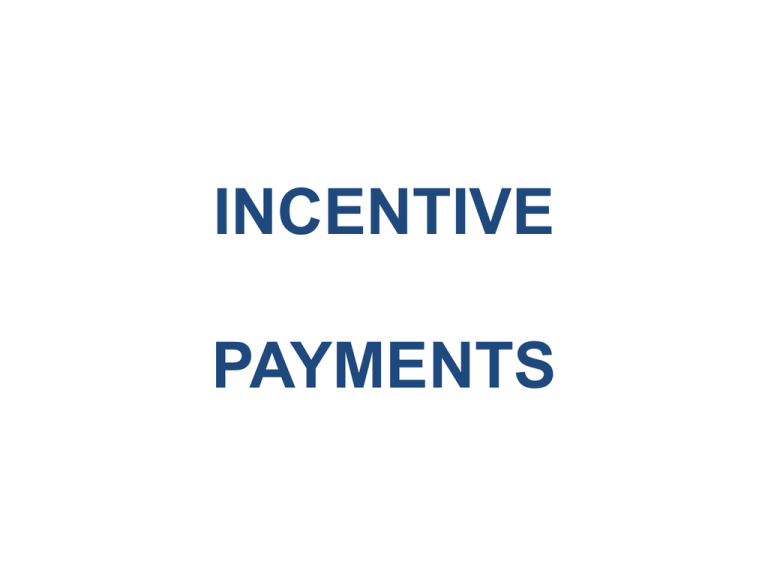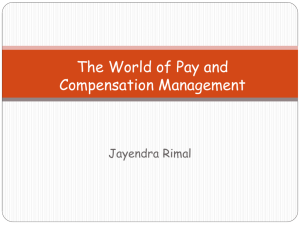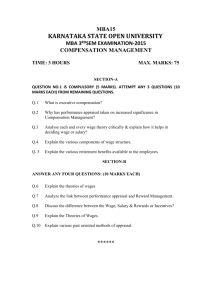Compensation Administration Organization Wide Incentive Plans
advertisement

17-1 EXCEL BOOKS INCENTIVE PAYMENTS • INCENTIVES AND EMPLOYEE BENEFITS Characteristics of a wage payment plan Simple Beneficial Equitable Guaranteed minimum wage Balanced Incentive-oriented Quality output Certainty Cost effective flexible Variable Pay Or Pay For Performance Systems Here the pay is linked to individual, group or organizational performance. Employees have to compete and deliver results. Three types of variable pay are commonly used: Individual incentives: they link individual effort to pay Group incentives: they link pay to the overall performance of the entire group Organization-wide incentives: here employees are rewarded on the basis of the success of the organization over a specified time period. Essentials of a sound incentive plan Guaranteed minimum wages Simple Equitable Economical Flexible Supported by workers and unions Motivating Prompt payment Compensation Administration Methods of wage payment Methods of Remuneration The Rate System Flat time High wage rate system Payment by Results Graduated time rate Piece rate system Straight piece work Differential piece work Taylor system Gantt task and bonus systems Premium bonus plans Group bonus system Combination of time and piece rate Profit sharing Merrick system Emerson efficiency system Point schemes Bedeaux Haynes Manit system system Halsey premium plan Rowan scheme Priestman’s production bonus Compensation Administration Accelerating premium bonus scheme Rucker plan Other incentive scheme Scanlon plan Towne plan Co-partnership Methods of Wage Payment Time wage system: A worker is paid on the basis of time spent on the work, irrespective of the amount of work done. Plus points Simple and easy to operate Guaranteed wages to workers Favoured by trade unions Good for precision jobs Minus points Makes no distinction between efficient and inefficient workers Offers very little to efficient workers Requires close supervision so that workers do not waste their time No relationship exists between wages and productivity Methods of Wage Payment Piece rate system: A worker is paid at a stipulated rate per piece or unit of output. This method is suitable where quality of work is not important, work is repetitive in nature, there is sufficient demand for output to guarantee continuous work and the job is a standardized one Plus points Encourages efficient workers to produce more Workers adopt better ways of getting things done, to earn more Idle time is reduced to the minimum Workers take every precaution to avoid machine breakdowns. Cost of supervision is less Methods of Wage Payment Minus points Delays beyond one's control could affect workers earnings adversely Beginners and slow learners are left behind in the race The focus on quantity would affect quality Workers may stretch themselves to unhealthy levels to earn more Encourages rivalry between workers Taylor's differential piece rate system: A worker is paid more finishes the assigned task before the stipulated time. if he Merrick's differential piece rate system: This method uses threerates; up to 83%of the standard output workers are paid at the ordinary piece rate; between 83% to 100% at 110% of the ordinary piece rate and above 100% at 120% of the ordinary piece rate. Compensation Administration Individual Incentive Plans Halsey plan: Here the worker gets a guaranteed wages based on the time, irrespective of whether the assigned work is completed or not. If the worker is able to finish the task in less than the standard time, he or she is entitled to get fifty (in some cases one third) per cent of time saved at time rate in addition to normal time wages. Rowan plan: It assures minimum time wages. Bonus is paid on the basis of time saved. But unlike a fixed percentage , it is calculated thus Bonus = Time saved/Standard time X Time taken X hourly rate Gantt task and bonus plan: Here time wages are guaranteed. Standard time for each task is fixed. Workers, who fail to finish the job within the time limits, get time wages. A worker who reaches the standard is paid time wage plus bonus at a fixed percentage (20 per cent)of normal time wages. If a worker exceeds the standards, he is paid a high piece rate. Compensation Administration Individual Incentive Plans Bedeaux plan: In this plan every operation is expressed in terms of standard minutes called as “B's” representing one minute. A worker gets time wages for 100 % performance; ie, finishing the job exactly as per standards set. If actual performance exceeds the standard performance in terms of B's then 75% of the wages of time saved is paid to worker as bonus and 25% is given to the foreman. Haynes manit plan: It is more or less like the bedeaux plan. Here the bonus is only 50 per cent as against 75 per cent, being paid to the efficient worker. Of the remaining 50 per cent, 10% goes to the foreman and the rest to management. Emerson's efficiency plan: If the worker achieves 67% efficiency, he gets bonus at a given rate. The rate of bonus increases gradually from 67% to 100%. Above 100% bonus will be at 20% of the basic rate plus 1% for each increase in efficiency. Accelerate premium bonus plan: Here the premium is paid at varying rates for increasing efficiency. Compensation Administration Bonuses It is an incentive payment granted to a worker at the end of a particular year, in addition to one’s normal standard wage. The Payment of Bonus Act, 1965 Compensation Administration Merit Pay Any salary increase awarded to an employee based on his or her performance is called merit pay. It is like rewarding the best performers with the largest increases in pay as an appreciative gesture from the employer. When high achievers are rewarded, they set the benchmarks for others to follow. But the whole process of recognising merit, measuring performance, picking up the winners need to be followed objectively. Compensation Administration Commissions For Sales People Compensation plans for sales personnel generally consist of a straight salary plan, a straight commission plan, or a combination of both. Evaluation of Incentive Plans Incentives based on performance would definitely motivate people to give their best to the organisation. They can improve their standard of living. Other benefits include; better use of facilities, reduced supervision; reduced lost time, absenteeism and turnover. There is, of course, the dark side of the moon and the research evidence in this regard is somewhat mixed. Compensation Administration Reasons for the failure of PFP systems Poor perceived connection between performance and pay Tendency of workers to speed up everything, leading to accidents, wastage of resources Workers may ignore basic safety precautions in order to produce more Workers have inflated ideas about performance levels and when they fail to receive expected rewards, they blame management Jealousies may arise among workers because some are able to earn more than others. Unions, not surprisingly, are opposed to PFP systems because these would go against the spirit of “all for one and one for all”. Often, setting acceptable, attainable, objective standards is not easy. All said and done, money is simply a hygiene factor and has only limited spur people to superior performance. Compensation Administration potential to Guidelines for PFP systems Develop and implement PFP systems in an atmosphere of mutual trust and confidence Make them easy to understand and implement Establish the relationship between effort and reward directly and clearly Recognize individual differences and set the targets keeping the expectations of people in mind. Show clearly what is there in the plan for an efficient worker, apart from the guaranteed wages. Compensation Administration Group or Team Based Incentive Plans Here all team members receive an incentive bonus payment when production or service standards are met or exceeded. Methods in this category include Preistman’s production bonus, Rucker plan, Scanlon plan, Towne plan and Co partnership. Under co partnership, the worker gets his usual wages, a share in the profits of the company and a share in the management of the company as well. Compensation Administration Compensation practices in India Companies like Mastek, Godrej and Boyce have tried to link their rewards to team based performance in recent times quite successfully Team based rewards: Best practices Set quantifiable targets when evaluating team performance for rewards. Ensure that top performers in each team earn the highest level of rewards. Link team performance closely to the company's profits and overall financial health. Avoid subjectivity when assessing both the team and its member's performance. Offer uniform non-team based incentives to employees within each grade. Other companies like Pfizer, Siemens have been linking rewards to shop floor workers based on the worker ability to meet productivity as well as performance targets. In any case, the emerging picture is quite clear especially in the post liberalisation era in India. The start that need entrepreneurial action from its employees will have to offer large doses of cash, goal linked incentive pay and possibly stock options to link compensation to profits. Mature companies, whose focus is on managing their earnings per share and protecting market shares, will have to seek out managerial talent and reward it with flexible tax-friendly compensation packages with benefits designed to improve the quality of working life. Compensation Administration Organization Wide Incentive Plans These plans reward employees on the basis of the success of the organisation over a specified time period. Profit sharing: Here the organisation agrees to pay a particular portion net profits (given in cash or in the form of shares) to eligible employees. of Gain sharing: It is based on a mathematical formula that compares a baseline of performance with actual productivity during a given period. When productivity exceeds the base line an agreed upon savings is shared with employees. Unlike profit sharing plans which have deferred payments, gain sharing plans are current distribution plans. These are based on individual performance and are distributed on a monthly or quarterly basis. Employee stock ownership plan: It provides a mechanism through which certain eligible employees (based on length of service, contribution to the department etc) may purchase the stock of the company at a reduced rate. Compensation Administration Organization Wide Incentive Plans Plus points Empower the employee to participate in the growth of a company as part owner and get a fair share of the cake. Helps the company to retain talented employees and make them committed to the job and the company Better industrial relations, supervision, are other benefits Compensation Administration reduced employee turnover, lesser Incentive Schemes For Indirect Workers Since Indirect workers also play a key role in manufacturing operations, their contributions need to be recognized and rewarded appropriately. The list of beneficiaries here would include repairs and maintenance staff, store staff, material handling staff, office staff etc. Such schemes, however, must be based on some agreed criteria aimed at improving the overall efficiency of the organization over a period of time. Compensation Administration Fringe Benefits These are extra benefits provided to employees in addition to the normal compensation paid in the form of wages or salaries. Features Supplementary forms of compensation Paid to all employees Indirect compensation, since they are not directly related to performance May be statutory or voluntary Need for fringe benefits Employee demands Trade union demands Employer's preference A kind of social security To improve industrial relations Compensation Administration Types of Fringe Benefits Types of Fringe Benefits Payment for Time not worked Hours of work Paid holidays Shift Holiday premium pay Retrenchment compensation Safety measures Canteens Consumer Credit Housing societies societies Employee security Safety and health Welfare recreational facilities Old age and retirement benefits Paid vacation Lay off compensation Workmen’s compensation Legal aid Health benefits Employee Welfare Holiday counselling organisations homes Educational Trans- Parties & Miscefacilities portation picnic llaneous Provident fund Pension Deposit linked insurance Gratuity Medical benefits Compensation Administration





